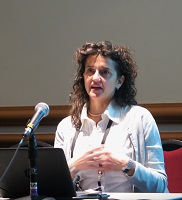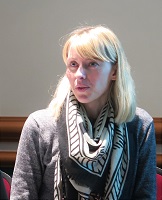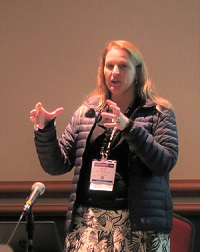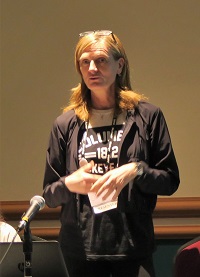USITT’s Annual Conference - Salt Lake City, Utah, USA
Salt Palace Convention Center, Room 252A
March 18, 2016 - 13:00-14:15 PM
Download the Presentation in PDF
Simona Rybáková welcomed the group and introduced herself. She told the attendees that the presentation's session would also cover the history and recent projects of the CDG.
I - CDG’s History
Simona Rybáková shared a slide show on the history of the CDG and acknowledged founding members (Simona Rybáková, Laura Crow, Virginia Vogel, Margaret Mitchell) who were present in the room.
Simona Rybáková presented images from projects led by or with significant contribution by CDG members. These included:
- the Extreme Costume Exhibition held at the PQ 2011. She also explained related symposia "Costume talks" and she suggests we have similar programming in Taipei at WSD 2017.
- the CDG programming that occurred in Cardiff at WSD 2013,
- the Helsinki programming for Critical Costume in 2015,
- the Tribes Project at the PQ 2015,
- and the exhibition Costume at the Turn of the Century, 1990-2015 at Moscow 2015. Simona Rybáková informed the CDG that this exhibition is ongoing.


II - Announcement
Upcoming WSD 2017 in Taipei:
Simona Rybáková asks for interested people to send general proposals to her email for CDG programming by April 15th, 2016.
The general theme of WSD 2017 appears to be “Transformation and how the spirit of Transformation energizes the creative power of theatre art.” But it is not known yet if the CDG has to follow this subject.
III - Artistic Presentations
Simona Rybáková (Czech Republic) - Costume Design as a Complex Discipline
The presentation included selections from her own recent theatre and film work which bring to her professional and personal life a broad range of themes, which on the surface might not appear to be related to costume design and her work in general, but are nevertheless integrated. Simona shared also her collaboration at Ohio State University (OSU, USA) - a devised project which grew out of a study of letters between her grandfather and his family during the time he fought at the Russian front in Siberia during the First World War.
Nic Ularu (Romania / USA) – Hieronymus
Nic Ularu presented Hieronymus, a play he wrote, directed and designed costumes and set which was performed at the National Theatre of Iasi, Romania and at La Mama in New York City. Nic said he is obsessed with the condition of the artist and he stated we are living our lives in darkness- in the darkness of the theatres… He wonders what drives us to be in this beautiful and painful process and way of life. He believes we are more than designers. Nic showed still images and video of the production which he designed wrote and directed.
Maria Jirásková (Czech Republic) - Fulguris: Between the Light & the Dark
Maria Jirásková showed a series of images of her work through the filters of metaphorical meanings of light and shadow. Work included site specific work, self- devised work and projection work. Maria showed her educational, theatre, ballet and film projects.
Sabrina Notarfrancisco (Germany / USA) – PQ Tribes Exhibition: a collision of art and life
Sabrina Notarfrancisco shared her work about her TD&T article on the Tribes project at the PQ 2015. Sabrina explained that Lise Klitten also designed the sound for her costumes. Other artists included in this presentation were Simona Rybáková, Sofia Pantouvaki and Aalto students, Hideki Seo, Wei Wei, Jose Miguel Marcarian, Marcelo Denny, Marcos Bulhões, Kamila Polivkova, Missimo Furlan, Riita Ikonen, Stephanie Ross and Christian Tsu-Ran, Anne Habermann, Charles Sturt.
Sofia Pantouvaki (Greece / Finland) - Costume Design and Artistic Research: designing through the actor.
Sofia Pantouvaki suggested designing from a central question or theme that starts from the costume or from the actor, instead of text. Sofia shared her work on two projects of artistic research done in Helsinki. She presented the theoretical concept developed by one of her students, that the costume designer works with ‘three selves’ of the actor: the private self, the professional self and the fictional self. In the first project, Sofia collected information from the biographies of actors and she transformed their memories and stories into embroidery on the period-inspired costumes. In the second project, an opera production of The Tempest, Sofia asked the actors to bring in objects related to the experience of rehearsing this opera. She interviewed the actors about these objects and about their life background, and then motifs based on the interpretation of these materials were developed for the costumes.
Juli Balázs (Hungary) - Experimental Projection Forming Figures and Space in Depth of Field. Juli Balázs showed her theatre work in Hungary, Germany, Austria. Julie explained methodologies for projections on actors for a production of Fahrenheit 451. Actors wearing white costumes were sandwiched between front and rear projections of the same video image. In some cases, the projections made the actor look transparent; if both images differed, the actor looked like an abstract moving image. Julie showed fascinating projection experiments for the production. She also shared a project, Costume History in Live Performance, in which she proposes to use actors in white period costumes as projection screens. Juli’s work sparked great interest, and it is the hope of the CDG that further experiments could be executed at WSD in Taipei.




IV. Conclusion
Rosane Muniz (Brazil) - Beyond Borders, Beyond Language
The presentation is a CDG conclusion about the group`s vision for future: how to create possibilities of cooperation between CDG and other Performance Design`s groups, such as Lighting Design, Sound Design and Space Design. Also, the presentation concludes the goal of this session: to show how plural/ multifaceted the CDG members are. Not only costume designers, but also researchers, professors, editorial coordinators, authors of scholarly articles, playwrights and directors.
Rosane Muniz shared some of her curatorial works, such as the Brazilian national exhibitions for PQ`11 and PQ`15, the Brazilian costumes at Extreme Costumes exhibition at PQ`11, the Brazilian costumes at the Moscow exhibition, Costume at the Turn of the Century, and, finally, the example of the OISTAT meeting and symposium in Brazil, E-Scapes, where there were collaborations of three OISTAT commissions (Performance Design, Education and Research) and working groups (Costume, Lighting and Sound). The conference was organized by a group (Rosane Muniz and Reija Hirvikoski from PDC, Aby Cohen and Ian Evans from EC, and Dorita Hannah from RC), with almost no money. It is an example of a diverse multidisciplinary art and scholarship that included papers, Flash Talks, workshops, roundtables, side programs, performances, and a bookstore. The conference was well documented and interviews were conducted.
Simona Rybáková continued the presentation with material about the Scenography Commission meeting in Tel Aviv 2006, where a workshop in collaboration between the CDG and the LDG was quite successful.
Simona Rybáková concluded the meeting calling attention to the collaborative and diverse work of the CDG. She suggested that the meetings in Brazil (2014) and Tel Aviv (2006) were the best examples for future cooperation with other working groups in Performance Design Commission. Members of the CDG desire future collaborations with other working groups and commissions.


Minutes recorded by Margaret Mitchell and revised by Simona Rybáková, Sofia Pantouvaki and Rosane Muniz